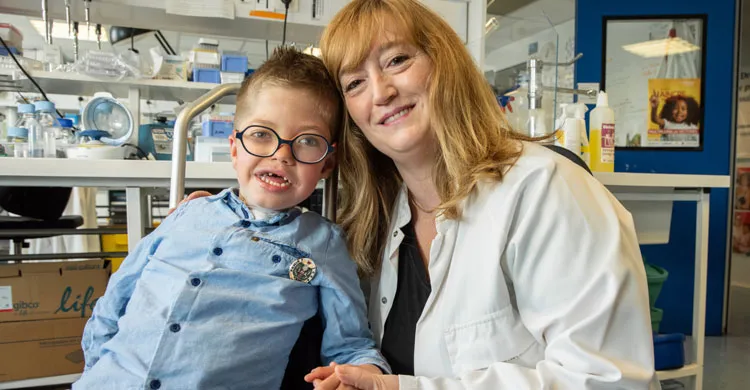Clinical results of the gene therapy trial in myotubular myopathy: efficacy on respiratory and motor functions in this extremely severe disease, challenges ahead
The journal The Lancet Neurology published on November 15 the clinical results of the gene therapy trial with a drug candidate designed at Généthon in 24 children suffering from myotubular myopathy, a rare and very severe muscle disease.

- The results published on November 15th in The Lancet Neurology demonstrate a major therapeutic effect on the acquisition of motor and respiratory functions in children with myotubular myopathy.
- After intravenous infusion of gene therapy treatment, 16 of the 24 children treated can breathe without assistance, 20 were able to sit up, 12 to stand and 8 to walk without support.
- Severe adverse effects observed in 4 patients are currently under investigation.
Yesterday, The Lancet Neurology published the clinical results of a gene therapy trial conducted by Astellas Gene Therapies, using a drug candidate developed at Genethon, in 24 children suffering from myotubular myopathy, a very severe muscle disease. This international trial, taking place in 6 investigating centers worldwide, including I-Motion, the Institute of Myology’s French pediatric clinical trials center, has enabled the majority of treated children to regain significant motor and respiratory capacities. 16 of them can now breathe without assistance, and 12 stand up on their own, and 8 can walk. Severe adverse effects, which caused the death of 4 children, are currently being investigated to understand their origin.
Myotubular myopathy is an X-linked genetic disease affecting 1 in 50,000 newborn boys. It is caused by mutations in the MTM1 gene encoding myotubularin, a protein involved in muscle cell function. It is characterized by extreme muscle weakness and severe respiratory distress. 50% of affected children die before age 18 months, and 75% before age 10.
The team led by Ana Buj-Bello, Research Director at Inserm and head of the “Neuromuscular Diseases and Gene Therapy” team at Genethon, designed this gene therapy, which consists in an adeno-associated viral vector (AAV8) delivering the MTM1 gene, and demonstrated its efficacy in models of myotubular myopathy. Building on the spectacular results obtained in the preclinical phases, a clinical trial, led by Astellas Gene Therapies, was launched in 2017. 24 children younger than 5 years suffering from myotubular myopathy and on respiratory assistance at least 22h a day were treated in two cohorts: 7 at the lower dose, 17 others at the higher dose. One patient was treated in France at I-Motion (Hôpital Trousseau – Paris), the Institute of Myology’s pediatric clinical trials center.
5 years after the start of the trial, the results show that:
- 16 children were able to do without respiratory assistance, previously indispensable 22 hours a day, between 14 and 97 weeks after treatment.
- 20 children could sit up for at least 30 seconds. Of these, 12 could stand up on their own and 8 could walk without support, whereas no child could do so before treatment.
- 4 children showing signs of pre-existing hepatobiliary pathology died. The trial has led to pause until understanding the origin of these complications.
The results of this clinical trial demonstrate major therapeutic effects, enabling children who were previously hypotonic, tracheostomized and gastrotomized, to breathe on their own, stand up and even walk. Gene therapy thus represents the first potential treatment for this rare and fatal disease.
“I’ve devoted my entire career working on myotubular myopathy. It took years of research to imagine, design and demonstrate the efficacy of gene therapy for this very severe and complex disease. Even though we absolutely must understand the reasons for the adverse effects observed in this clinical trial, it is exceptional to see children who were known to be doomed make incredible progress thanks to this drug candidate,” emphasizes Ana Buj-Bello, Head of the “Neuromuscular Diseases and Gene Therapy” team at Genethon, Research Director at Inserm and co-author of the preclinical work that led to this clinical trial.
“These clinical results show both how spectacularly effective gene therapy can be, and the challenges that remain, particularly in terms of adverse effects in certain contexts. While our teams are already committed to understanding and anticipating these issues, the knowledge gained from this clinical trial, which highlights certain limitations and particular hepatic susceptibilities, is rich in lessons for the entire scientific community. I would like to salute the excellence of Ana Buj-Bello’s work, which has led to major therapeutic effects in the majority of children treated, and which represents the first potential treatment for this rare and fatal disease,” adds Frédéric Revah, CEO Genethon.
“We had the opportunity to administer this innovative molecule to a first patient in France in 2020 at I-Motion. His evolution is reassuring, but as with all studies, we remain vigilant about follow-up”, Andreea Seferian, Neuropediatrician at I-Motion Pediatric Clinical Trials Platform and trial investigator.
Discover the progress of the young patient treated in France (french)

